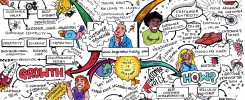Which of your stakeholders are most important – investors, staff, the board, regulators? Which strategy are you implementing: Opex reduction, innovative product development, digital transformation?
Latest thinking is that the customer comes first because they are the source of your profit. The customer is your profit centre, not the product. This is because in today’s world the customer decides whether to spend with you or not and whether to buy again with you. And their expectations are rising faster than your delivery. Customers who are fully engaged with your business spend more, buy more often, are not as price sensitive and have a massively higher lifetime value. Advocates may even recruit customers for you.
Putting the customer first means asking the right questions to learn how customers think and determine how best to serve them. Many companies have made a start with Customer Experience (CX) initiatives delivering change into the service operation but this is not enough. CX2.0 is Customer Centricity meaning the whole organisation is focussed on the customer, not just the service operation. That’s likely a massive structural and culture change.
How do you make a start? Here are some thoughts:
#1 Leadership
Like any transformative change success requires a clear vision, exceptional strategy and relentless execution. This needs visible leadership from the top but the execution of the strategy needs an accountable executive with transformation and cross functional skills. A strong process with communication and metrics is required but do not underestimate the cultural change – with new mindsets, breaking down silos, cross functional reporting lines and letting go of top down command and control across the whole business to reward “customer first” behaviour.
This executive role may be called “Chief Customer Officer (CCO)” and needs real authority, likely with cross functional teams reporting in. It is instructive that “marketing” has largely relinquished what might be seen as their traditional role as the discipline has become too focussed on short-term digital responsiveness at the expense of a deeper strategic and commercial responsibility and failed to deeply understand the customer. Customer centricity, like brand, is an investment in long term, sustainable, business value.
#2 Involve the Customer
You probably think you understand your customers, after all there is lots of data, and your salespeople visit customers. But to develop customer centric strategy you need to go back to basics and really get under the skin of customers. You need to involve customers to find out what they value, because customer value is what they are prepared to pay for. You will likely find that a lot of your current business activity and investment is actually wasted or even reducing value in the eyes of the customer.
Use a deep understanding and dialogue with customers to develop a customer centric business plan and a customer value proposition for each segment that defines the Customer Experience including product and service characteristics in terms of customer journeys. Then be prepared to develop the offer continuously because customer expectations are changing and getting more demanding all the time. This is where collaborative design – involving the customer – fits with Agile iterative development.
#3 Culture Change
Benefits from Customer Centricity are often visible financially within a year, but the real return is longer term and to embed compounding benefit requires the organisational culture to change. The biggest challenge to transformation is organisational resistance which can’t simply be invoked through top-down mandate. Often CX initiatives are championed by the CEO and picked up enthusiastically by the call centre staff. But true customer centricity CX2.0 requires the entire company’s participation to change their way of working. It needs to live in the collective hearts and minds of “how we do things round here” from IT, marketing, finance, to compliance, releasing optimism, trust and creativity.
#4 Good Data
Surprisingly most organisations keep data at product level and it can be quite a challenge to surface customer data in a format that can be used to manage the customer experience across channels, products, service contacts, customer journey and over time. Integrating data and tacit knowledge held in silos like CRM, marketing engagement platform, billing and product usage becomes essential to get an accurate picture. Working out the customer lifetime value by segment and indeed by individual customer can be eye opening. It is important to recognise that data is not insight and while you will want to collect customer input 360 degrees from every touch point you should continue to talk with customers – involving customers – because this creates insight from data, firing up energy and creativity to evolve and innovate, and customer propositions that resonate.
Working out the relationship between Net Promotor Score (NPS) and ROI (or DCF) is a great way to convince investors that Customer Centricity is a level headed financial strategy that is working for your business.
I believe building value for customers should be the central focus for every business. A leadership vision for customer centricity and relentless dedication to its results will improve ROI, enable successful innovation, increase employee engagement and drive greater overall customer satisfaction. Take the first step by talking to BeyondCuriosity.
BeyondCuriosity is a specialist insight agency for innovation, CX and growth
To learn more call Chris Little 07957686366 chris@beyondcuriosity.com




https://waterfallmagazine.com
Wonderful site you have here but I was wanting to know
if you knew of any user discussion forums that cover the same topics talked about
in this article? I’d really like to be a part of online
community where I can get opinions from other experienced individuals that share the
same interest. If you have any suggestions, please let me know.
Cheers!